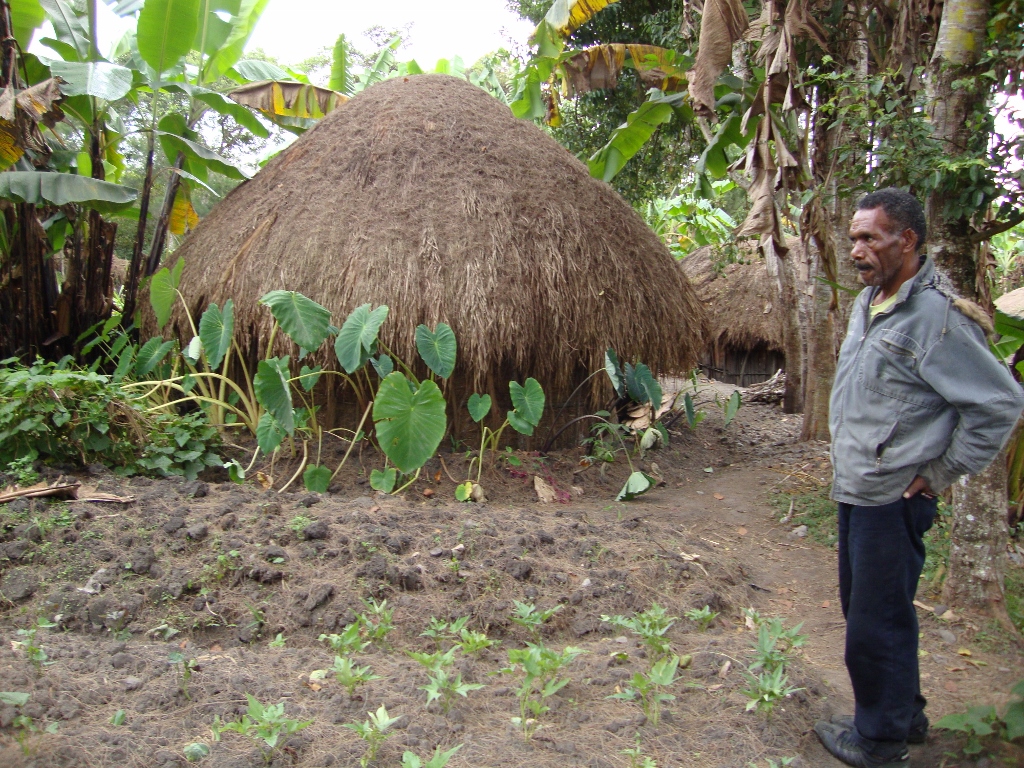Hunger remains a problem in many Indonesian households
Jeff Nielson
 Dani man in front of sweet potatoes, taro, bananas and hut- Jeff Neilson
Dani man in front of sweet potatoes, taro, bananas and hut- Jeff Neilson
In the highlands of western Flores, life can be difficult for farmers like Yohanes, his wife and their four children. He owns a wet-rice field and plants corn and beans on the side. He also maintains several hundred coffee trees, the cherries from which are his only source of cash income. Located on the slopes of Mount Ranaka, it is a picturesque rural idyll in a region of apparent agricultural abundance. And yet, the UN World Food Programme ranks Yohanes’ district of Manggarai as ‘extremely food insecure’.
Yohanes shares the rice field with his three brothers. The harvest is never enough to sustain his family throughout the year. He needs to buy additional rice or corn from the nearby market in Ruteng. But with coffee prices having recently fallen due to oversupply, and the harvest another two months away anyway, he has little hope of accessing the food sold at the market. Yohanes has neither the skills nor the education to secure off-farm employment. As a result, his family is reduced to one meal per day, prepared from pulverised cassava roots mixed with corn. Undernourished, the children have little chance to thrive academically in the local village school.
By contrast, only a few hundred metres away, Mariana and her family are relatively food secure. Not because her lands are fundamentally more fertile (in fact, she’s landless), but because her son is sending her regular remittances from Balikpapan, East Kalimantan, where he works for a construction company. As a result, she is able to access the food sold in Ruteng.
Food insecurity in Indonesia is experienced by individuals, like Yohanes, and households who do not have the ‘capabilities’ to earn an adequate livelihood that would allow them to access food that is otherwise available.
Sukarno’s vision for a food-secure Indonesia
In 1952, in the early years of Indonesian independence, President Sukarno gave a passionate speech at the laying of the first stone for a new Agriculture Faculty at the University of Indonesia campus in Bogor. The president used the opportunity to talk about food security – ‘a matter of life and death for the nation’. He likened the spectre of future food shortages in Indonesia to a pistol being held to the nation’s metaphorical head. Sukarno’s constant personification of the nation meant that it appeared logical to him to equate food security with self-sufficiency on a national scale.
‘Why bother talking about political freedom,’ Sukarno asked in the speech, ‘if we don’t have freedom to manage our rice, and always have to beg for help buying rice from our neighbouring nations.’
Here, Sukarno set the ideological tone for the way the problem of food security would be framed in Indonesia for the next 60 years. He presented the problem of food security in a mathematical way: balancing national rice production with calorie consumption requirements and population. It was fundamentally necessary to increase food production nationally, he argued, by expanding the total area under rice production through forest conversion; by intensifying production with new varieties of rice; by subsidising the domestic manufacturing of fertilisers; and by offering farmers technical agronomic advice. He also envisaged the development of broadacre dryland agriculture, mimicking the food bowls of the North American prairies, as a ‘way-out’. For scholars of food security, this was an approach that emphasised increasing the ‘availability’ of food.
Ironically, Sukarno’s inability to manage the problem of food insecurity was an underlying cause of his fall from power in 1965. The spectre of famine has always been a persistent, and sometimes volatile, political issue in Indonesia. During the early 1960s, a combination of drought; a rat plague on Java; the destruction of crops due to the eruption of the Mount Agung volcano on Bali; and disastrous economic policy resulted in large-scale food shortages across the archipelago. A 1964 article in Time Magazine, ‘Indonesia: Of Rice and Rats’, described the dire situation: ‘Nearly 1,000,000 people were on a starvation diet in Java; scores have already died of malnutrition. Peasant villages emptied as food supplies dwindled, and native families poured into already overcrowded cities’. Indeed, ramifications from the 1964 rice crisis and associated food riots are still felt in the political formulation of food policy in Indonesia today.
Undernourished in Suharto’s land of plenty
Suharto’s New Order regime made national food security a central pillar of economic and social policy, and put into practice some of Sukarno’s rhetoric. For President Suharto, rice self-sufficiency at the national scale reflected a dominant international perspective on food and hunger. It was a view widely held until as recently as the mid-1990s. It prioritised production-centric explanations aimed at maintaining domestic food stocks. In other words, his policy placed an emphasis on the narrow definition of ‘food availability’.
During the 1970s and 1980s, Indonesia did achieve remarkable progress towards improving the availability of food domestically. The government provided subsidies for credit, fertilisers and irrigation, restricted rice imports, and regulated prices through a public purchasing program implemented by the National Logistics Agency (BULOG). As a result of these policies, Suharto received an award from the Food and Agriculture Organisation during the 1985 World Food Summit for successfully transforming the country from being the world’s largest rice importer to being self-sufficient. This achievement was widely celebrated within Indonesia, fuelling a strong sense of nationalistic pride and instilling a deeply held belief in the population of the inherent cultural significance of a nation being able to feed itself.
The nation may have had sufficient rice, but what about individual households? The broader notion that food insecurity might actually be experienced by the household, or by individuals like Yohanes, rather than by the abstract notion of the nation, was entirely absent from Sukarno’s 1952 speech. It has remained largely absent from public discourse ever since. Rural households, it seems, enter the food security equation primarily as obstacles to modernisation, or possibly as units of production, rather than as individuals that potentially experience food insecurity as a lived reality.
As highlighted by the Nobel prize-winning economist Amartya Sen in his paradigm-shifting study of the Bengal famine of 1943, food availability does not prevent famines if food insecure households do not possess the necessary ‘capabilities’ to access that food. According to Sen, capabilities refer to the positive freedoms enjoyed by individuals in their social function, derived for example from their skills, education and good health that allow individuals to improve their livelihoods. Sen’s ideas prompted a shift in food security policy globally away from a single-minded focus on food availability to concerns over food accessibility, and subsequently to a third dimension of food nutrition. It is not that food availability is unimportant. Availability is a critically important element to the broader picture of food security, and Indonesia’s apparent resilience in the face of a global food crisis of 2008 was arguably due to adequate domestic supplies of rice. However, availability is not sufficient to ensure food security where it is needed – within the household.
Accessing food in Indonesia today
Food insecurity is unevenly distributed across the archipelago. Indonesia’s Food Security and Vulnerability Atlas (FSVA), jointly released in 2010 by the World Food Programme (WFP) and the National Food Security Agency, identifies 30 districts (out of the then 346 districts in total) as receiving Priority 1 ranking according to its Composite Food Security Index — and thus experiencing ‘chronic food insecurity’. Of these 30 districts, 16 were concentrated in the Papua and West Papua provinces, and six were in East Nusa Tenggara province. These districts are food insecure primarily because communities and households lack the capabilities to access food when subsistence production fails. Indeed, it is a sad irony that most food insecure households in Indonesia are households that are engaged primarily in subsistence food production, such as in western Flores.
Similarly the localised food shortage and famine that struck the Yahukimo district in the Papuan highlands in late 2009 was not because there was insufficient rice available nationally. It was because households whose subsistence-based sweet potato gardens were affected by a plant disease lacked capabilities and were isolated from broader trade and social networks. As a result, they could not access the rice available at the national level.
In recent years, the Indonesian government has introduced programs such as the Rice-for-the-Poor program (Beras Miskin or RASKIN), which have attempted to explicitly address food insecurity at the household level. Introduced in 2002 as a substitute for broader price controls under BULOG, RASKIN improved the entitlements of targeted poor households through a ration of medium-grade rice (varying but set at about twenty kilograms per month). While the program has had its share of problems, it has undoubtedly provided a welcome lifeline for many food insecure households. For the most part, however, the government continues to prioritise costly national-level food self-sufficiency (in rice, corn, soybean, sugar and beef) in its current food security policy, rather than addressing the greater challenge of enhancing individual household access to food.
Perhaps the most audacious policy consequence of a production-oriented approach to food security in Indonesia has been the move to establish the Merauke Integrated Food and Energy Estate (MIFEE) in Papua province. According to government advocates, MIFEE has lofty goals of dramatically increasing production of rice, corn, sugar, soybeans and palm oil. Seen by some as a thinly veiled resource grab by corporate investors, serious questions have arisen regarding the environmental and social implications of the project. It is possible that large areas of sago palms (an important food staple for the local indigenous population) will be replaced in the process. It is sadly ironic that the rhetoric of national food security is being invoked to justify actions likely to exacerbate food accessibility issues for traditional communities living in this critically food-insecure province. The folly of such an approach highlights the perils of prioritising food availability at the national level, while ignoring drivers of food insecurity at the household level.
Singularly prescriptive policy approaches, such as ‘self-sufficiency at all costs’ or ‘full liberalisation of agricultural markets’, are unlikely to solve the food security conundrum in Indonesia. Food security is most likely to be achieved through broad-based rural development, where household livelihood strategies are supported to improve access to resources and factors of production through a capabilities approach.
Jeff Neilson (jeffrey.neilson@sydney.edu.au) is a senior lecturer in geography at the University of Sydney, where he teaches and conducts research on environmental management and rural development across Indonesia. He recently contributed a chapter about food security in Indonesia toFood Systems Failure: The Global Food Crisis and the Future of Agriculture (2012, Earthscan/Routledge).











